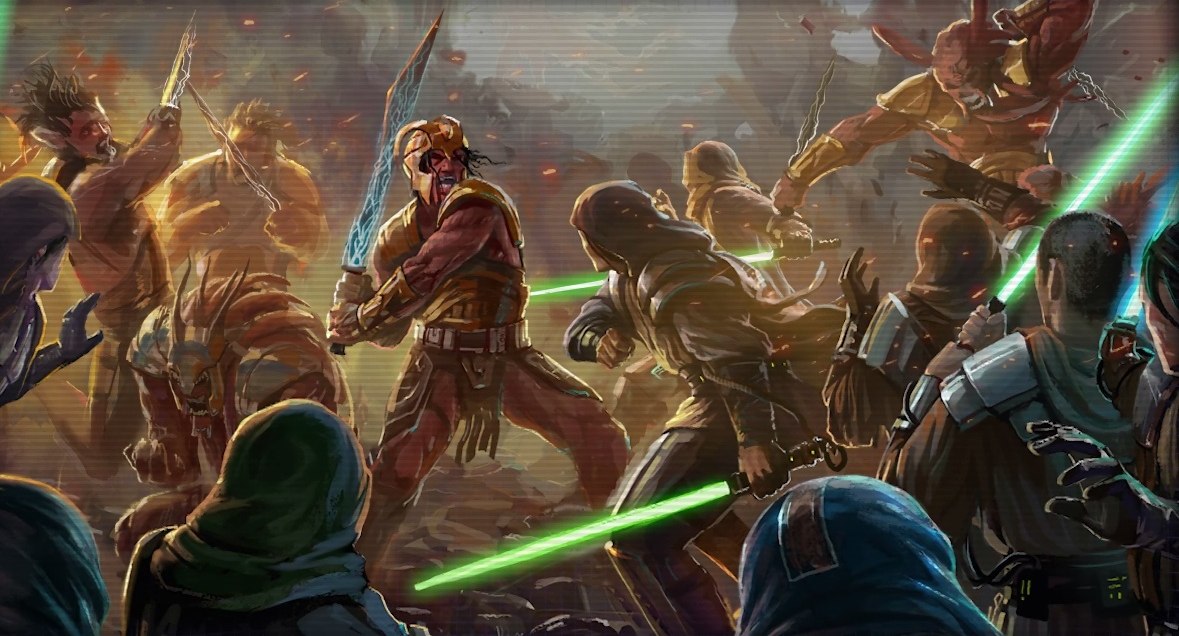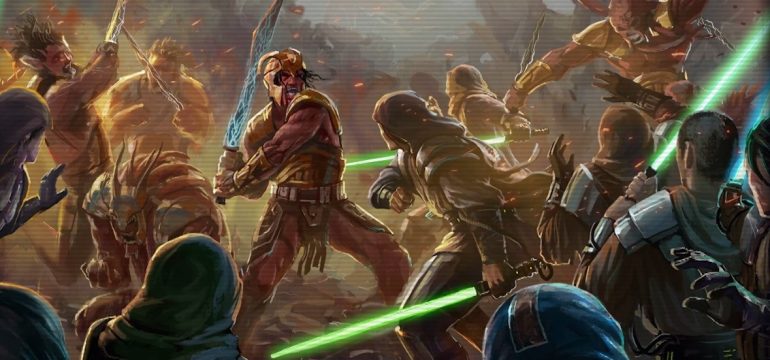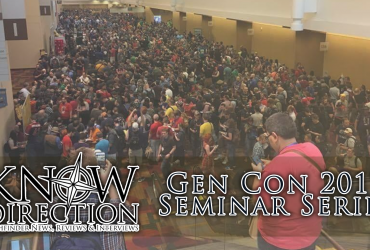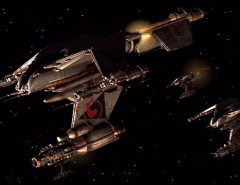
Face it, this is what you were thinking.
I got an interesting request from a fan last week—provide two builds, a soldier and a solarian, and math out which class is better at dealing damage. Obviously, EVERYONE wants to know about melee, so I did a weapon solarian versus a melee soldier. Are you ready? Let’s get pumped!
Build Basics
Soldier Build
- Class: Soldier 12
- Feats: Weapon Focus (1st), Deadly Aim (Bonus; 2nd), Weapon Specialization (Bonus; 3rd), Mobility (3rd), Spring Attack (Bonus; 4th), Cleave (5th), Lunge (Bonus; 6th), Fleet (7th), Step Up (Bonus; 8th), Opening Volley (Bonus; 9th), Step Up and Strike (9th), Great Cleave (Bonus; 10th), Shot on the Run (11th), Penetrating Attack (Bonus; 12th)
- Class Features: soldier’s onslaught
- Fighting Styles: blitz (Primary), hit and run (Secondary)
- Gear Boost: Melee Striker (3rd), Armored Advantage (7th), Bullet Barrage (11th)
- Weapon of Choice: Ultra Thin Curveblade (3d10 S, Bleed 2d6)
Solarian Build
- Class: Solarian 12
- Feats: Weapon Focus (1st), Weapon Specialization (Bonus; 3rd); Deadly Aim (3rd), Mobility (5th), Lunge (7th), Spring Attack (9th), Step Up (11th)
- Class Features: flashing strikes, sidereal influence (any two graviton and any two proton), skill adept (any two), solar manifestation (weapon 4d6), solarian’s onslaught, stellar mode
- Stellar Revelations: black hole / supernova (1st), stellar rush (2nd), gravity anchor (4th), plasma sheath (6th), defy gravity (8th), corona (10th), reflection (12th)
- Zenith Revelations: solar acceleration / wormholes (9th)
- Weapon of Choice: Minor Gluon Crystal (+1d6, Severe Wound)
Using this build, we can see a lot of similarities in playstyle. Both builds basically have the ability to move and full attack (the soldier gets the ability to make a free guarded step or move action during his full attack, while the solarian can full attack as a standard action). Both have the ability to attack twice at the end of a charge. The soldier is MUCH better at ranged than the solarian; he had room for Shot on the Run and Bullet Barrage in his build, and he gets his Weapon Specialization bonus on attacks made with longarms. The solarian has better mobility, though—wormholes, solar acceleration, defity gravity, all of these allow him to just be wherever he wants.
Mathematical Calculations
So the first part of our assessment is going to involve looking at the raw damage output of these two classes: soldier and solarian. Remember, when looking at damage output we want to concern ourselves with averages, and the average on any die is equal to half the maximum result + .5. We’ll also assume both characters started with an 18 Strength and took the +4 Personal Upgrade in Strength, as well as a Strength increase at 5th and 10th level. All in all, this would leave our characters with a theoretical 24 Strength, or a +7 modifier. With this in mind, damage looks like this:
Soldier
- Attack Bonus: (12 + 7 (Str) + 1 (Weapon Focus) = +20)
- Base Damage: 16.5
- Ability Score: +10 (see class features)
- Class Features: Melee Striker (1-1/2 times Strength on damage rolls)
- Feats: Deadly Aim (–2 Atk for +6 damage), Weapon Specialization (+6 damage)
- Standard Action: +18 to Hit, average damage result of 38.5
- Full Attack: +14 to Hit, average damage result of 38.5 per Hit.
Solarian
- Attack Bonus: (12 + 7 (Str) + 1 (Weapon Focus) = +20)
- Base Damage: 14
- Ability Score: +7
- Class Features: Plasma Sheath (+6 fire damage if fully attuned to photon; counts as 3 because its not always active), Corna (deals 6 fire damage to anyone who starts adjacent to the Solarian if fully attuned to photon; counts as 3 because its not always active)
- Feats: Deadly Aim (–2 Atk for +6 damage), Weapon Specialization (+6 damage)
- Standard Action: +18 to Hit, average damage result of 32
- Full Attack: +15 to Hit, average damage result of 32 per Hit.
So these numbers are good, but what’s the chance of these characters actually hitting in combat? Glad you asked, dear reader! So the Alien Archive isn’t out yet, meaning we don’t have great benchmark goals that are public knowledge for KAC and EAC. However, the necrovite (from First Contact) is CR 13, which is close enough; it’s a slightly challenging encounter with a KAC of 27. So let’s see how our heroes fare! (Assuming our characters use all of their most-damaging tricks, of course.)
Soldier
- Attack: KAC 23 versus 1d20 + 18. The soldier needs a 5 to hit the necrovite, meaning that he has a 20% chance to miss (he misses on a 4, 3, 2, and 1, and each has a 5% chance to turn up on the die). This means we can take the soldier’s average damage for a standard action and multiply it by 80%, for a practical average of 30.8 damage (38.5 * 80%).
- Full Attack: KAC 23 versus 1d20 + 14. The soldier now needs a 9 to hit the necrovite, meaning that he has a 40% chance to miss (he misses on an 8, 7, 6, 5, 4, 3, 2, and 1, and each has a 5% chance to turn up on the die). This means that our first hit will, on average, deal 23.1 damage (38.5 * 60%). However, our soldier gets a total of three attacks, so what’s the chance that all three attacks will hit? We simply multiply the chance of hitting (.6) by itself three times. (.6 by .6 by .6, or 21.6%); in this way, Starfinder’s flat iterative penalties makes the math easier. Anywaym what we do now is multiply the average damage for three hits (38.5 * 3 = 115.5), then multiply that sum by our percentage that it will happen (115.5 * 21.6%), or 24.948.
Solarian
- Attack: KAC 23 versus 1d20 + 18. The solarian needs a 5 to hit the necrovite, meaning that he has a 20% chance to miss (he misses on a 4, 3, 2, and 1, and each has a 5% chance to turn up on the die). This means we can take the soldier’s average damage for a standard action and multiply it by 80%, for a practical average of 25.6 damage (32 * 80%).
- Full Attack: KAC 23 versus 1d20 + 15. The soldier now needs a 8 to hit the necrovite, meaning that he has a 35% chance to miss (he misses on an 7, 6, 5, 4, 3, 2, and 1, and each has a 5% chance to turn up on the die). This means that our first hit will, on average, deal 20.8 damage (32 * 65%). However, our solarian gets a total of three attacks, so what’s the chance that all three attacks will hit? We simply multiply the chance of hitting (.65) by itself three times. (.65 by .65 by .65, or 27.4%). Now we multiply the average damage for three hits (32 * 3 = 108), then multiply that sum by our percentage that it will happen (108 * 27.4%), or 29.592.
The Results
Contrary to popular believe in the toxic Starfinder community, the Solarian is mathematically better at full attacking than the soldier because of flashing strikes. That accuracy boost is HUGE, and as you can see it gives them a noticeable edge in the effective damage of their full attack. Not calculated into this is the fact that Corona’s damage is technically automatic and not requiring an attack roll; I’d imagine that the solarian’s damage would actually be a few points higher if I did take the time to parse that out, but I’m lazy. Sorry!
Its worth noting, however, that the soldier will usually APPEAR to be beating the solarian damage-wise. The soldier’s attacks hit harder individually, and bigger bonuses means that the numbers will be bigger. But in a fight where the solarian can stand still and do his thing, on average his damage will be higher compared to a similarly built soldier, if only by a little bit.
Whelp, that’s all I’ve got for today. Hopefully I’ve convinced you that these are two well-built, well-balanced classes that totally deserve to be played. And with that, I bid you until next time. Take care!
Alexander “Alex” Augunas has been playing roleplaying games since 2007, which isn’t nearly as long as 90% of his colleagues. Alexander is an active freelancer for the Pathfinder Roleplaying Game and is best known as the author of the Pact Magic Unbound series by Radiance House. Alex is the owner of Everyman Gaming, LLC and is often stylized as the Everyman Gamer in honor of Guidance’s original home. Alex also cohosts the Private Sanctuary Podcast, along with fellow blogger Anthony Li, and you can follow their exploits on Facebook in the 3.5 Private Sanctuary Group, or on Alex’s Twitter, @AlJAug.






Personally, I’m a fan of both classes. My first (or, I suppose, seven hundred and first?) Starfinder Society character is a melee soldier that I made because CHAINSAW SWORDS AND JETPACKS. That said, NOT-LIGHTSABERS POWERED BY THE STARS is pretty awesome, and I love how our friendly neighborhood Star-bros add an entirely different feel in playstyle; the pendulous Stellar Mode mechanic reminds me of Wow’s Balance Druids and that’s a very fun thing to see in a pen and paper RPG.
…I just wish your Solar Manifestation’s color could shift with your Stellar Mode. The fixed color thing is bothering me way more than it should.
Thank you for doing comparison builds! Those both look like they’d do a ton of work in melee range, and be fun to play.
Sadly, in your full-attack analysis, you only took into account the case that you hit all three times, and not all eight possible combinations (for example, if you hit the first and second, but miss the third, you aren’t counting that towards their damage). This makes it look significantly worse for full attacking than the real numbers. Here’s the calculations for the full-attack DPR using your numbers.
Solarian:
(32*3)*(.65*.65*.65) + (32*2)*(.35*.65*.65)*3 + 32*(.35*.35*.65)*3 = 62.4
Soldier:
(32*3)*(.6*.6*.6) + (32*2)*(.4*.6*.6)*3 + 32*(.4*.4*.6)*3 = 69.3
(*note on the “extra” *3 on the second and third groups: that’s the number of combinations that result in two or one hits)